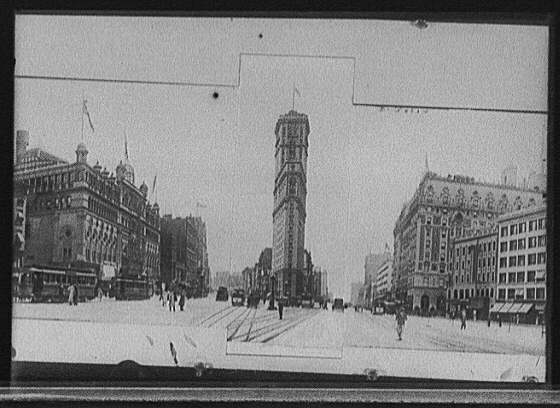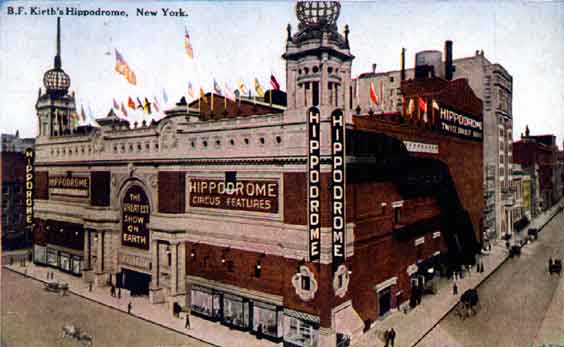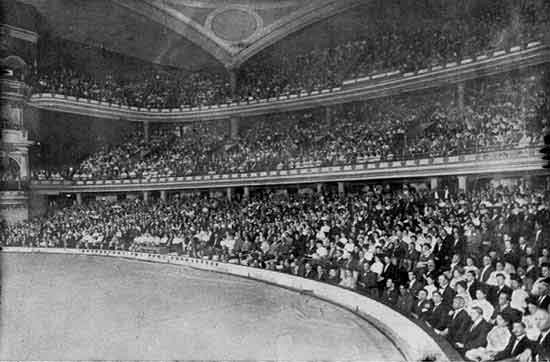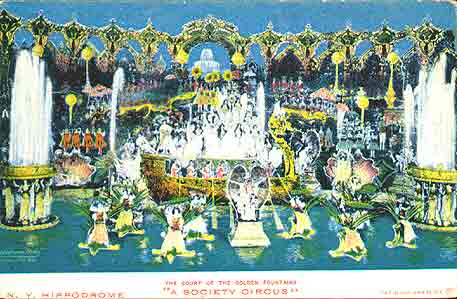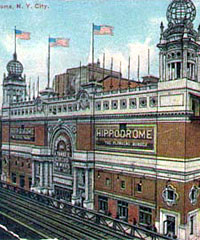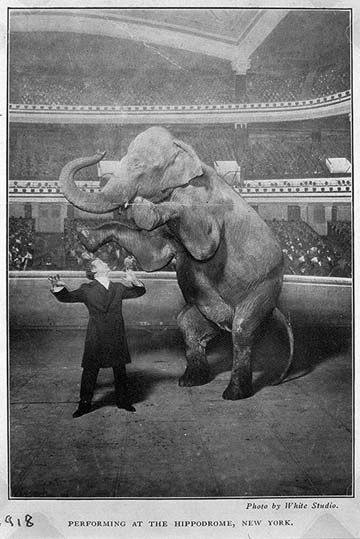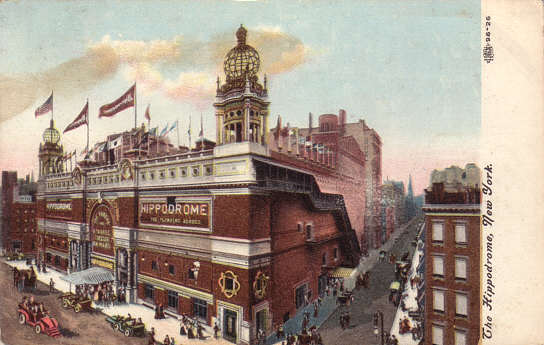The Hippodrome Theatre stood in New York City from 1905 to 1939, on the
site of a what is now a large modern office building known as "The
Hippodrome Center", at 1120 Avenue of the Americas, in the Theater
District of Midtown Manhattan. It was called the world's largest theatre
by its builders.
The Hippodrome was built by Frederick Thompson and Elmer Dundy, creators
of the Luna Park amusement park at Coney Island. The theatre was located
on Sixth Avenue, now named Avenue of the Americas, between Forty-third
and Forty-fourth streets. Its auditorium seated 5,300 people and it was
equipped with what was then the state of the art in theatrical
technology. The theatre was acquired by The Shubert Organization in
1909.
Construction
With J. H. Morgan as architect, the Hippodrome first opened in 1905 with
a seating capacity of 5,200, and is still considered as one of the true
wonders of theatre architecture. Its stage was 12 times larger than any
Broadway "legit" house and capable of holding as many as 1,000
performers at a time, or a full-sized circus with elephants and horses.
It also had an 8,000-gallon clear glass water tank that could be raised
from below the stage by hydraulic pistons for swimming-and-diving shows.
The glory years
For a time the Hippodrome was the largest and most successful theater in
New York. The Hippodrome featured lavish spectacles complete with circus
animals, diving horses, opulent sets, and 500-member choruses. Until the
end of World War I, the Hippodrome housed all sorts of spectacles then
switched to musical extravaganzas produced by Charles Dillingham,
including "Better Times," which ran for more than 400 performances.
When Dillingham left in 1923 to pursue other interests, the Hippodrome
was leased to Keith-Albee, which hired Thomas Lamb to turn it into a
vaudeville theatre by building a much smaller stage and discarding all
of its unique features. The most popular vaudeville artists of the day,
including illusionist Harry Houdini, performed at the Hippodrome during
its heyday. Others might vanish rabbits, but in 1918, on the
brightly-lit stage of the Hippodrome, Houdini made a 10,000-pound
elephant disappear. He created a sensation. When Houdini fired a pistol,
Jennie vanished from view.
The Hippodrome's huge running costs made it a perennial financial
failure, and a series of producers tried and failed to make money from
the theatre. It became a location for vaudeville productions in 1923
before being leased for budget opera performances, finally becoming a
sports arena.
Decline and fall
In 1922, the elephants that graced the stage of the Hippodrome since its
opening moved uptown to the Bronx's Royal Theater. On arrival, stage
worker Miller Renard recalled, the elephants were greeted with
extraordinary fanfare:
The next day the Borough President gives them a dinner on the lawn of
the Chamber of Commerce up on Tremont Avenue, with special dinner menus
for the elephants. It was some show to see all those elephants march up
those steps to the table where each elephant had a bail of hay. The[n],
the Borough President welcomes the elephants to the Bronx, and the place
is just mobbed with people. And that was the worst week's business we
ever done in that theatre.
In 1925, movies were added to the vaudeville, but within a few years,
competition from the newer and more sumptuous movie palaces in the
Broadway-Times Square area forced Keith-Albee-Orpheum, which was merged
into RKO by May 1928, to sell the theatre. Several attempts to use the
Hippodrome for plays and operas failed, and it remained dark until 1935,
when producer Billy Rose leased it for his spectacular Rodgers & Hart
circus musical, Jumbo, which received favorable reviews but lasted only
five months due to the Great Depression.
After that, the Hippodrome sputtered through bookings of late-run
movies, boxing, wrestling, and Jai Lai games before being demolished in
1939 as the value of real estate on Sixth Avenue began to escalate. The
New York Hippodrome closed on August 16, 1939. Unfortunately, the start
of World War II delayed re-development, and the Hippodrome site remained
vacant until 1952, when it was taken over for a combination office
building and parking garage.
Chronological Program List
March 26, 1907, Double billing of "Neptune's Daughter" (opera) and
"Pioneer Days" (drama). In between the two performances, a variety of
circus acts entertained.[1]
Legacy
The building was torn down in 1939, though an office building and
parking garage that today stands on the same site claims the name "The
Hippodrome Center." [2] Through the 1960s the modern building was the
corporate headquarters of the old Charter Communications Inc. media
publishing company.
In the 1970s the famous old theater also gave its name to the nearby
"Little Hippodrome", a drag and comedy club which was located at 227
East 56th Street, between Second and Third Avenues. The club is famous
for hosting the final live New York performances of the legendary Glam
rock group, The New York Dolls in March 1975, a month before the group
disbanded. [3] The show recorded at that venue appeared later as the
group's Red Patent Leather album. [4] Soon after in 1975 that location
of the defunct Little Hippodrome club re-opened as The East Side Club, a
gay men's social club. [5]
The largest theater in New York City is now Radio City Music Hall.
References
^ Theatre record and scrap book, 1904-1908. Clarke Historical Library
(located inside Park Library, CMU campus) manuscript. Mt. Pleasant, MI
^ The Hippodrome Center, Star Office Space
^ From the Hip, "It's All the streets you crossed not so long ago" blog,
October 18, 2005, from Nina Antonia, "Too Much, Too Soon" London:
Omnibus, 1998, and Village Voice ad, March 30, 1975
^ Live in NYC - 1975, mp3.com
^ East Side Club home
Kenneth Jackson (1995). Encyclopedia of New York City. Yale University
Press. ISBN 0-300-05536-6.
|
|
With J. H. Morgan as architect, the
Hippodrome first opened in 1905 and is still considered as one of the
true wonders of theatre architecture. Its stage was 12 times larger than
any Broadway "legit" house and capable of holding as many as 1,000
performers at a time, or a full-sized circus with elephants and horses.
It also had an 8,000-gallon clear glass water tank that could be raised
from below the stage by hydraulic pistons for swimming-and-diving shows.
Until the end of WWI, the Hippodrome housed all sorts of spectacles,
then switched to musical extravaganzas produced by Charles Dillingham,
including "Better Times," which ran for more than 400 performances. When
Dillingham left in 1923 to pursue other interests, the Hippodrome was
leased to Keith-Albee, which hired Thomas Lamb to turn it into a
vaudeville theatre by building a much smaller stage and discarding all
of its unique features. In 1925, movies were added to the vaudeville,
but within a few years, competition from the newer and more sumptuous
movie palaces in the Broadway-Times Square area forced Keith-Albee, by
then merged into RKO, to sell the theatre. Several attempts to use the
Hippodrome for plays and operas failed, and it remained dark until 1935,
when producer Billy Rose leased it for his spectacular Rodgers & Hart
circus musical, "Jumbo," which received favorable reviews but lasted
only five months due to Depression conditions. After that, the
Hippodrome sputtered through bookings of late-run movies, boxing,
wrestling, and jai lai games before being demolished in 1939 as the
value of real estate on Sixth Avenue began to escalate. Unfortunately,
the start of WWII delayed re-development, and the Hippodrome site
remained vacant until 1952, when it was taken over for a combination
office building and parking garage.
The New York Hippodrome
One year following the opening of Luna Park, Thompson & Dundy made a
small step and a giant leap towards Manhattan. In 1905 the Hippodrome on
Sixth Avenue between 43rd and 44th street is built, only one block away
from the newly named Times Square. With it, the entrepreneurs radically
changed the world of Times Square in two ways. First, its low admission
prices were aimed at the middle class, who had thus far been unable to
visit the costly legitimate Broadway theatres. Second, it brought the
high-tech pleasures of the amusement parks to the inner city. The
combination of these two factors made the Hippodrome what Thompson
called a "gigantic toy" for the masses. "The toymaker of New York", as
he had proclaimed himself, however, had designed it not for children,
but for the adult consumer.6 In Thompson's opinion, the
turn-of-the-century American adult suffered from too much work and too
little play. He had first created the enlarged playground that allowed
them to return to their childhoods. As was the purpose of Luna Park, the
fantastic shows at the Hippodrome would temporarily offer an escape for
its visitors away from their grim world.
The idea of building a hippodrome in New York City was not entirely new.
Circus-director P.T. Barnum had built the Roman hippodrome between 26th
and 27th streets in Manhattan. Its many imported spectacles were closely
related to the circus, such as chariot races and Wild West violence. But
even Barnum's 8000-seat circus paled in comparison with the proposal
made by Steele Macay for the Spectatorium. The 10,000-seat Spectatorium
was to be built as a permanent theatre for the Columbian exposition in
Chicago in 1893. Macay's ideals closely resembled those of Frederic
Thompson; he dreamt of "subsidizing the genius of the whole world, for
the education and inspiration of the masses, while affording them, at
moderate prices, and entertainment as irresistibly fascinating as it was
ennobling."7 The Spectatorium, however, was never completed, after
investors had been frightened away by a stock market collapse known as
the Panic of 1893. It is very likely that Thompson, while working at the
Columbian exposition, became aware of Macay's plans and subsequently
inspired by his ideas.
In 1901 Thompson moved to New York following the Pan-American exposition.
Disappointed by the entertainment the city had to offer to the abundant
middle-class audience, Thompson & Dundy tried to put a hippodrome at
39th street and 7th Avenue, but were thwarted by opposing neighborhood
residents. For the time being, they concentrated on Coney Island.8
Following the success of Luna Park, the two had little trouble finding
investors for the Hippodrome. The profits made from Luna Park had been
substantial, but not nearly enough to finance the price of the
Hippodrome, the property, and its stage entertainment, which Thompson &
Dundy advertised as $3,500,000. Together, they were able to convince a
number of powerful businessmen and financiers, not impresarios or
showmen, of the viability of their unique formula of amusement as a
money-making investment.
Construction of the Hippodrome was completed in 10 months, another
record-breaking achievement, made possible by the fact that the
construction company was owned by one of the financial backers. When
construction had begun, residents of the area expressed their
disapproval of the project, which had come to them as a great surprise.
The Theatre Syndicate, who held a near monopoly on theatrical
productions in the US, allegedly tried to delay the Hippodrome's
construction through the city Building Department.
Nonetheless, the 5200-seat Hippodrome opened April 12, 1905 performing two
double-feature shows six days a week. 9
Department store theatre (democratizing theatre)
The concept of the Hippodrome was also inspired by the fairly new
department store, which had begun to increasingly dominate the face of
urban retailing at the turn of the century. These enormous stores,
offering a lavish amount of different goods attracted millions of
consumers, and promoted shopping as an important and entertaining
activity. Their innovative advertising and merchandising schemes were
particularly aimed at middle-class women. The stores offered various
free services available to all customers regardless of their ability to
buy. Thus, shopping had been democratized; the city's wealthiest and
humblest walked the same aisles even if they could not buy the same
products. "We are coming to the age of the department store in
theatricals," Thompson stated in 1904. "The masses are ready to welcome
it."10
The Hippodrome had, according to Thompson, democratized theatre-going in
the same way that department stores had democratized shopping. Like in
the department stores, the wealthy and the humble were able to
experience together the same abundance of pleasures.11 The masses
themselves, however, were an important part of the experience. A smaller
theatre-house with a more expensive admission price may well have been
able to collect the same amount of money, but would lack the grandeur of
a hippodrome. Consequently, the Hippodrome demanded packed houses to
afford to present its high-tech theatrical extravaganza.
Oscar Hammerstein, a producer of numerous shows and builder of "the
grandest amusement temple in the world," the Olympia, back in 1895,
predicted that "The theatres will suffer immensely...for at least the
first six weeks." and "The enormous crowds that will naturally be
attracted to the novelty of this establishment must come from somewhere,
and they will be drawn from the regular theatres." Others predicted an
overall decline in theatre ticket prices, and the Theatre Syndicate
subsequently brought their prices down to one dollar.12
The Hippodrome's amusement, however, did not only challenge the elite
entertainment, but also the popular Barnum & Bailey circus. Thompson &
Dundy had raided several circuses for arena acts, including the Barnum &
Bailey and the Ringling Brothers Circuses. Barnum & Bailey arranged a
non-competition agreement with Ringling Bros., in exchange for which
Ringling broke its agreement to provide further acts for the Hippodrome.
Thompson & Dundy boasted that they had obtained all the billboard space
available in New York. The Barnum & Bailey Circus struck back in 1905 by
announcing it would begin the longest circus season in New York's
history.13
Thompson & Dundy had collected the greatest talents in choreography,
costume and stage design, writers and composers from around the world
for their gargantuan opening shows. The shows A Yankee Circus on Mars
and A Society Circus were eclectic spectacles combining vaudeville,
pantomime, circus and popular songs with technological novelties.
Electricity was used in every conceivable way in the Hippodrome, from the
obvious to the inventive. The entire block-long facade was itself an
electrical billboard, that "threw a fire and glare of electric
illumination for miles." When approaching the theatre, "a tumult of
sudden light hit you on the eyeballs ... you couldn't possibly pass it
by unnoticed."14 The Hippodrome threw the spark that would forever light
Times Square. The inside of the theatre was as much an unequalled
lighting spectacle. The amount of current used by the Hippodrome's stage
was more than the average electrical station could supply. Electricity
also warmed the grease paint and curling irons for hundreds of chorus
girls; wardrobes used electric irons to press costumes; carpenters
heated their glue with electricity; chefs used electric ovens and
dishwashers; the building itself was supplied with an electrified
heating and cooling system, water pumps, telephones, hydraulic elevators
and mechanical hoists, and numerous other electrical conveniences.15
In 1906, Thompson & Dundy lost their creation to their financial backers.
Shocked by an unexpected decline in attendance during the Hippodrome's
second season, the investors battled with the producers to raise ticket
prices. Furthermore, the investors were concerned by Thompson's plans
for an amusement park in Manhattan, which they viewed as a competitor of
the Hippodrome. Thompson & Dundy joined the Theatre Syndicate that same
year, and continued to produce theatre shows together, until Dundy's
untimely death in 1907. In the latter half of the century, an office
tower was placed on the site of the Hippodrome; only the name remains in
silver-colored lettering on the modernist facade.
NOTES
6. "Gigantic toy" quotation comes "Opening of Hippodrome," New York
Tribune (April 13, 1905); "New York's Gigantic Toy," p.243-244 7. Percy
MacKaye, Epoch; The Life of Steele MacKaye, Genius of the theatre, New
York 1927; "New York's Gigantic Toy," p.245 8. "New York's Gigantic
Toy," p.245-248 describe Thompson's pre-Luna life. More about Thompson's
Peter Pan-like character is described on p.266-270. 9. "New York's
Gigantic Toy," p.250-253 10. " ‘Big Store' Idea to Give Masses
Entertainment," New York Morning Telegraph (September 26, 1904); "New
York's Gigantic Toy," p.248 11. "New York's Gigantic Toy," p.248-249 12.
Vincent Sheean, Oscar Hammerstein I: The Life and Exploits of an
Impresario, New York 1956; "New York's Gigantic Toy," p.250-251. 13.
"New York's Gigantic Toy," p.251 14. untitled article by Alan Dale (ca.
April 13, 1905); "New York's Gigantic Toy," p.257 15. A close
description with photographs of the Hippodrome lighting apparatus and
other uses of electricity appear in "Electricity at the New York
Hippodrome," Electrical World 47 (May 5, 1906) p.911-916, and "The
Illumination of the New York Hippodrome," Illuminating Engineer 1 (April
1906), p.72-77; "New York's Gigantic Toy," p.257-258 ; IMAGES: The New
York Hippodrome, postcard c. 1905; Cover detail of "Souvenir Book of the
New York Hippodrome," The Theatre Collection, Museum of the City of New
York; Inventing Times Square
Thanks to http://home.luna.nl
New York City's Hippodrome Closed Its
Doors for the Last Time
August 16, 1939
Would you like to watch Harry Houdini, legendary magician and escape
artist, make an elephant disappear right in front of your eyes? Or watch
diving horses while a 500-member chorus sings in triumph? Or see some of
your favorite comedians and singers perform live on a huge sparkling
stage? Back in the 1920s, you could have seen all this at New York
City's famous Hippodrome Theater. But on August 16, 1939, the Hippodrome
closed its doors for the last time.
Built in 1905 with a seating capacity of 5,200 people, the Hippodrome was
at one time the largest and most successful theater in New York. It
featured lavish spectacles complete with circus animals, diving horses,
opulent sets, and 500-member choruses. The most popular vaudeville
(variety stage) artists of the day, including Harry Houdini, performed
at the Hippodrome during its heyday. But by the late 1920s, the growing
popularity of motion pictures replaced the vaudeville acts and circus
spectacles presented at the Hippodrome.
In 1928, RKO, the motion picture company, purchased the theater. Movie
screens took over the stages for audiences who were hungry for this new
kind of entertainment. After it closed its doors in 1939, the Hippodrome
Theater presented its final spectacle: the building's demolition. The
era that made the Hippodrome famous lives on in the American memory. Do
you know the names of any other stars from that vaudeville era? Ask a
grandparent!
|


